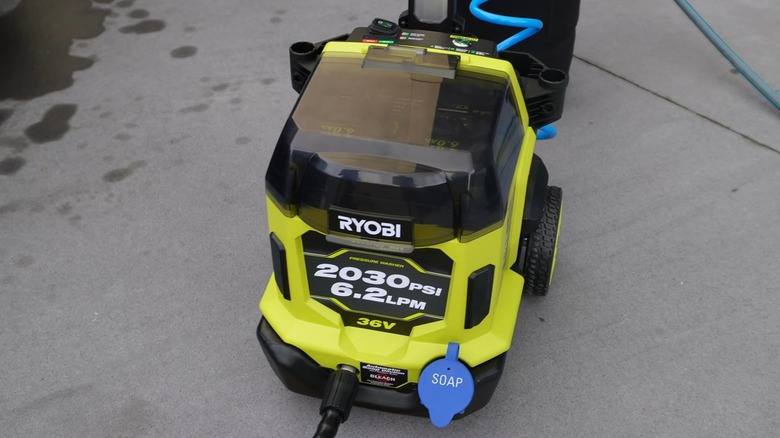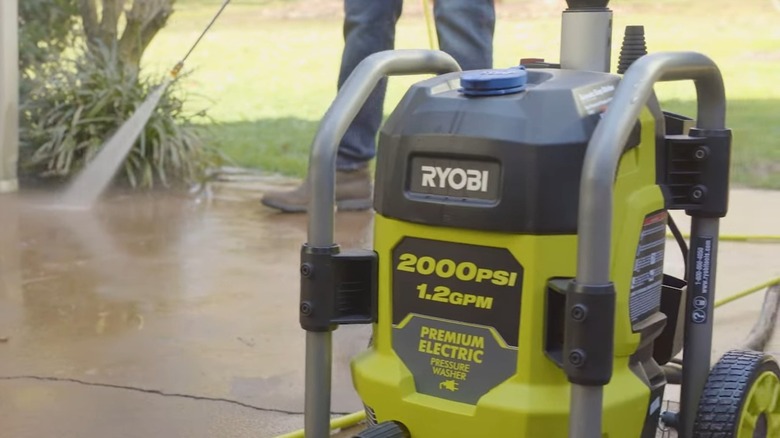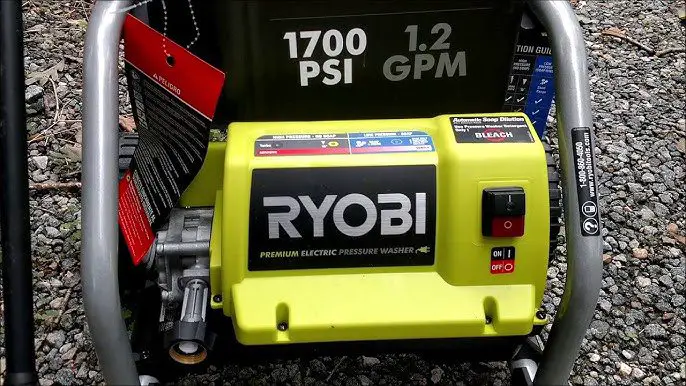Winter is coming, and with it comes the challenge of protecting your Ryobi pressure washer from the harsh cold. You’ve invested in this powerful tool to make cleaning tasks easier, and the last thing you want is to find it damaged when you need it most.
Imagine the frustration of pulling your pressure washer out of storage, only to discover it won’t start or has costly repairs due to freezing temperatures. Don’t let winter catch you off guard! In this guide, you’ll learn simple yet effective steps to winterize your Ryobi pressure washer, ensuring it stays in top condition and ready to tackle any cleaning job when warmer days return.
By following these steps, you can save yourself time, money, and the headache of unexpected repairs. Read on to discover how you can keep your pressure washer safe, functional, and ready for action.
Contents
Preparing Your Pressure Washer
Prepare your Ryobi pressure washer for winter by draining water and adding antifreeze to prevent damage. Store it in a dry place to ensure it remains in good condition for spring. Regular maintenance helps extend its lifespan.
Winter is coming, and it’s time to ensure your Ryobi pressure washer is ready to face the cold months. Preparing your pressure washer for winter is not just about storing it away; it’s about taking the right steps to protect your investment. Whether you’ve had your pressure washer for years or just bought it recently, winterizing it properly ensures it will serve you well when spring arrives. ###Gather Necessary Tools
Before you start, gather all the necessary tools. You don’t want to get halfway through the process only to realize you’re missing something crucial. A few essential items include a wrench set, a bucket, and a pair of gloves. You might also need some antifreeze or pump saver solution. Having everything at arm’s length makes the winterizing process smoother. Imagine stopping mid-task because you can’t find your wrench; it’s frustrating, right? So gather your tools first to save time and avoid unnecessary stress. ###Safety Precautions
Safety should always be a priority when working with machines. Start by disconnecting the power supply to your pressure washer. Ensure the machine is on a flat, stable surface to prevent it from tipping over. Wear gloves to protect your hands from any sharp edges or hot surfaces. Think about the last time you handled a tool without gloves and regretted it. Also, make sure the area is well-ventilated, especially if you’re using chemicals like antifreeze. As you prepare your pressure washer, consider the benefits of being thorough now to prevent headaches later. What steps will you take to make sure your pressure washer is ready for action when winter ends?
Credit: www.slashgear.com
Cleaning The Pressure Washer
Winterizing your Ryobi pressure washer starts with cleaning. A clean washer ensures efficient operation. It also prolongs the life of the machine. Begin by focusing on key components.
Rinsing External Components
Start with the exterior. Use a garden hose to rinse off dirt. Pay attention to the nozzle and hose connections. These areas often collect grime. Clear them thoroughly to prevent blockage.
Inspect the spray wand too. It can gather debris over time. A clean spray wand ensures smooth water flow. Make sure all external parts are spotless.
Removing Residual Detergent
Leftover detergent can cause issues. It may lead to clogs or corrosion. First, empty the detergent tank completely. Rinse it out with warm water. This removes any detergent traces.
Next, run clean water through the system. Connect the pressure washer to a water source. Let water flow through the unit for a few minutes. This will flush out any remaining detergent.
Check the detergent siphon tube for residue. Clean it if necessary. A clear tube ensures proper detergent flow in the future.
Draining Water Systems
Winterizing your Ryobi pressure washer involves draining water systems efficiently. This prevents damage from freezing temperatures. Proper drainage ensures longevity and optimal performance.
Emptying The Water Pump
First, turn off the pressure washer. Disconnect it from any water supply. Tilt the washer to allow gravity to drain the pump. Ensure no water remains inside. This reduces the risk of internal freezing.
Clearing Hoses And Nozzles
Disconnect hoses from the pressure washer. Hold each hose upright. Let water flow out completely. Use compressed air for stubborn water. This clears any remaining droplets.
Nozzles can harbor moisture. Detach them from the hose ends. Shake out any trapped water. Store them in a dry location. Proper storage prevents rust or damage.

Credit: www.youtube.com
Adding Antifreeze
Prevent freezing damage to your Ryobi pressure washer by adding antifreeze. This simple step protects internal components from cold temperatures. Ensure proper winterization for longer equipment life.
Adding antifreeze to your Ryobi pressure washer is crucial for winterizing. This process protects the pump from freezing temperatures. Without proper care, your pressure washer can suffer damage. By using antifreeze, you ensure your equipment stays in top condition. Let’s explore how to choose and apply antifreeze effectively.Choosing The Right Antifreeze
Select antifreeze designed for pressure washers. This type prevents corrosion and freezing. Ensure it is safe for pump seals and hoses. Compatibility is essential. Check the label for specifications. Avoid automotive antifreeze; it can damage internal parts. Opt for biodegradable options to protect the environment.Applying Antifreeze To The Pump
Start by disconnecting the water supply. Ensure the pressure washer is off and cool. Locate the pump inlet and outlet. Attach a siphon tube to the antifreeze bottle. Insert the tube into the pump inlet. Slowly squeeze the bottle to fill the pump. Watch for antifreeze exiting the outlet. This signals the pump is full. Repeat if necessary to ensure complete coverage.Storing The Pressure Washer
Prepare your Ryobi pressure washer for winter by draining all water and adding antifreeze. Protect hoses and nozzles from freezing by storing them in a dry, sheltered area. Regular maintenance keeps your equipment ready for spring cleaning tasks.
Winter is coming, and you need to prepare your Ryobi pressure washer for the cold months ahead. Properly storing your pressure washer ensures it remains in top condition and ready for use when warmer weather returns. A few simple steps can protect your investment and keep it running smoothly for years to come. ###Selecting The Right Storage Location
Choosing the perfect spot for your pressure washer is more important than you might think. Look for a location that is dry and shielded from harsh weather conditions. A garage or shed often works well, as they offer protection from freezing temperatures and moisture. Remember the time when I left my pressure washer outside, thinking it was durable enough? The freezing temperatures damaged it, leading to costly repairs. Learn from my mistake and find a safe, indoor space. Your pressure washer will thank you for it. ###Covering And Protecting The Unit
Once you have chosen a suitable storage location, think about how to protect your pressure washer from dust and dirt. Using a protective cover can make a significant difference. A simple tarp or a dedicated pressure washer cover helps keep the unit clean and free from debris. Consider the impact of small particles on the machine’s performance. They may not seem like a big deal, but accumulated dust can impair functionality over time. A cover acts as a barrier, ensuring your pressure washer stays in peak condition. Have you ever wondered how to make these steps part of your routine? By dedicating just a few minutes at the end of the season, you can ensure your pressure washer is ready to tackle any task when spring arrives. Taking these small actions now pays off in the long run, saving you time and money.
Credit: www.slashgear.com
Maintenance Tips For Winter Storage
Prepare your Ryobi pressure washer for winter. Drain all water to prevent freezing damage. Clean and dry components thoroughly. Store in a cool, dry place to ensure optimal performance next season.
As winter approaches, it’s crucial to ensure your Ryobi pressure washer is ready for storage. Proper maintenance during the cold months can prolong its lifespan and keep it working efficiently. Think of this as a simple routine check-up, akin to what you might do for your car before a long trip. By following these maintenance tips, you’ll be ready to power through the next season without any hiccups.Inspecting For Wear And Tear
Before you tuck your pressure washer away, give it a thorough inspection. Check hoses and connectors for any cracks or leaks. These small issues can escalate if left unattended during the winter months. Examine the spray gun and wand for signs of rust or damage. If you spot any issues, make a note to replace these parts before the next use. This proactive approach can save you time and frustration when you need your pressure washer again.Lubricating Moving Parts
Lubrication is key to keeping your pressure washer’s moving parts in top shape. Apply a light lubricant to the pump and other moving components. This prevents rust and ensures smooth operation when you start it up again. Remember, a well-lubricated machine runs more efficiently and saves you from costly repairs down the line. Have you ever tried starting your car after a long break without checking the oil? Your pressure washer deserves the same care. Regular maintenance is not just about preserving equipment; it’s about being prepared. How ready do you want to be when spring cleaning demands your attention? By addressing these details now, you’ll be ahead of the game when warmer weather beckons you back outdoors.Frequently Asked Questions
How Do I Winterize My Ryobi Pressure Washer?
To winterize your Ryobi pressure washer, first drain all water from the unit. Remove hoses and accessories, and store them separately. Next, add pump saver antifreeze to the pump, ensuring it circulates through the system. Finally, store the pressure washer in a dry, cool place to prevent damage from freezing temperatures.
What Materials Are Needed For Winterizing?
You’ll need a pump saver antifreeze solution, a bucket, and basic tools like pliers and screwdrivers. A clean cloth is helpful for wiping down surfaces. These materials ensure that your Ryobi pressure washer is protected from freezing and corrosion during winter storage, extending its lifespan and maintaining performance.
Can I Store My Washer Outside In Winter?
It’s not recommended to store your pressure washer outside during winter. Freezing temperatures can damage the pump and hoses. Instead, store it in a dry, insulated area like a garage or shed. This protects it from the elements, ensuring it remains functional and ready for use when warmer weather returns.
How Often Should I Winterize My Pressure Washer?
You should winterize your Ryobi pressure washer once a year before the first freeze. Regular winterization prevents damage from freezing and prolongs the machine’s life. This annual maintenance routine ensures optimal performance and readiness for spring cleaning tasks, preserving your investment in the equipment.
Conclusion
Winterizing your Ryobi pressure washer ensures it lasts longer. It’s a simple process. Drain water completely. Clean all parts thoroughly. Store in a dry place. Use a cover for protection. This prevents rust and damage. Regular maintenance keeps it ready for spring.
Follow these steps each winter. Your washer stays in top condition. Save money on repairs. Enjoy reliable performance next season. A little effort goes a long way. Keep your pressure washer safe and sound. Winter care is essential. Happy cleaning when warmer days return!

